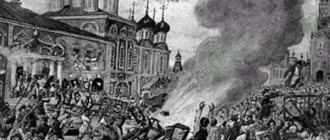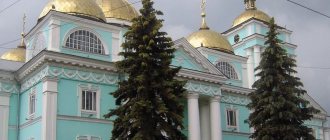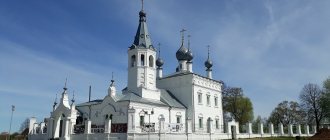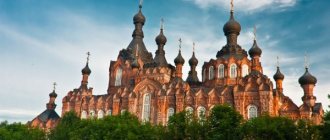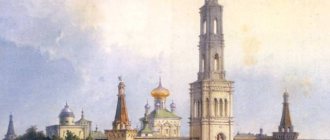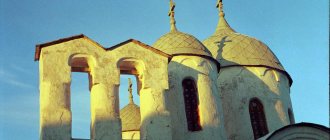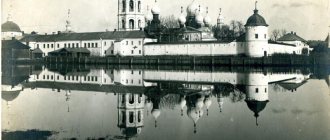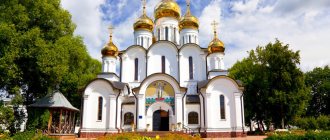History of the monastery
At the beginning of the 15th century, on the right bank of the Moscow River, in Zamoskvorechye, the monastery of St. John the Baptist appeared. The first written evidence of it dates back to 1415. In the 1530s, Vasily III and Elena Glinskaya had a son, the future Tsar Ivan IV the Terrible. In honor of the birth of the long-awaited heir, the monastery was moved to an area called Kulishki and made a women's monastery.
The Orthodox monastery enjoyed special patronage from the royal family. Representatives of the ruling dynasty made festive appearances here and took part in religious processions. In addition, the monastery received rich gifts and was upset by the money of eminent princely families - the Lobanovs, Khovanskys, Volkonskys, Golitsyns and Meshcherskys.
Many women from noble families took monastic vows at the monastery. It is also known that state criminals or schismatics were sent to the St. John the Baptist Convent. So, in 1768, the landowner Daria Saltykova or “Saltychikha”, convicted of cruelty, was in the monastery church.
In 1812, when Napoleon's troops entered Moscow, the city was engulfed in flames. The monastery found itself in the midst of a terrible fire, so almost all the monastery buildings burned down. Only the stone cathedral church remained intact. There were not enough funds to restore the monastery, so it had to be abolished for some time, and the nuns were forced to settle in other Moscow monasteries.
General view of the monastery and the Cathedral of the Beheading of John the Baptist
A few years later it was possible to rebuild the cathedral church and part of the cells. The church became a parish church, and the cells were made into apartments for employees of the Synodal Printing House. Only in the 1860-1880s was the monastery completely reconstructed. According to the project prepared by the famous Russian architect Mikhail Dormidontovich Bykovsky, the monastery was built almost anew.
It is noteworthy that all construction work was done not with government money, but with private donations. Capital in the amount of 600 thousand rubles came from Colonel Elizaveta Makarova-Zubacheva, who died in 1858. Thanks to her, Muscovites received a unique architectural ensemble, made in the best traditions of the neo-Renaissance.
From the end of the 19th to the beginning of the 20th century, the monastery flourished. During the Russian-Turkish War, the only infirmary for the wounded in the city was located on its territory. The miraculous icon of John the Baptist was kept in the monastery, and there was an icon-painting workshop.
Famous prisoners and centuries-old secrets of the monastery
Often the Predtechensky Monastery was used as a prison to imprison criminals or representatives of the royal authorities. Thus, in the 16th century, Ivan the Terrible’s daughter-in-law Paraskeva was held there.
For more than thirty years, the monastery was the place of imprisonment of the cruel landowner “Saltychikha”, who was arrested in 1768. The women's monastery is also known for the forced monasticism of Elizabeth Petrovna's daughter, Princess Tarakanova.
Later, the nun accepted her fate and became a famous ascetic.
The monastery during the years of Soviet power
After the revolution, the measured life of Moscow monasteries changed dramatically. In 1919, one of the twelve city concentration camps was organized at the St. John the Baptist Monastery, where criminals and anyone suspected of disloyalty to the authorities were taken.
View of the monastery from Zabelina Street
Later, a special purpose camp was created in the monastery. Since 1923, it turned into a forced labor camp, and after another 4 years - into a department of a state institute where crime and criminals were studied. In the early 1930s, the monastery camp became part of a factory labor colony.
After the monastery was closed, the nuns and novices were evicted from the city, and they began to live in the Chernetsovo farmstead near Moscow. In 1929, the entire monastic economy was nationalized, a large tax was levied on the nuns, and they had to sell off all their property.
For two years, the nuns survived through odd jobs and alms. In 1931, an active anti-religious campaign began in the country. It was decided to isolate the nuns as members of an anti-Soviet group. The women were convicted, placed in Butyrka prison, and then sent into exile in Kazakhstan.
In the early 1990s, when the monastery churches began to be handed over to believers, they were in disrepair. Then the church buildings were restored and consecrated, and in 2002 a convent was restored on the territory. Large-scale restoration work in the monastery was led by the architect-restorer Olga Andreevna Danilina.
View of the monastery from Khokhlovsky Lane
Architectural monuments
The prototype of the monastery ensemble was the famous Florentine Cathedral of Santa Maria del Fiore. In the center of the monastery stands the Cathedral of the Beheading of John the Baptist. It was built in 1879 according to the design of M. D. Bykovsky and has two chapels - St. Nicholas the Wonderworker and the icon of the Kazan Mother of God. Like the Cathedral of Florence, the Church of St. John the Baptist ends with an expressive faceted dome.
The monastery has a unique courtyard layout. The cathedral and the surrounding temples and buildings are connected by four one-story galleries or arcades. Thanks to them, the interior space is divided into small rectangular and trapezoidal courtyards.
To the east of the cathedral church there is a hospital building with the Church of the Great Martyr Elizabeth. The two-story building is reminiscent of beautiful Italian palazzos. It was founded in 1860, but construction was interrupted by the Russian-Turkish War, so the church was consecrated only in 1879. During the years of Soviet power, the temple was closed. The premises were used as a club, and then it was occupied by an organization that was in charge of the city heating networks.
From Zabelina Street, a small chapel of John the Baptist adjoins the monastery fence. The one-story building with an elegant portal was built in 1881. During the years of Soviet power, the Moscow heating network services were also located here. Today, inside the chapel there is a copy of the icon with a particle of the relics of John the Baptist and the copper hoop of St. Elizabeth the Wonderworker.
View of the monastery from Maly Ivanovsky Lane
In the northern part of the monastery there are two symmetrical bell towers, very similar to the towers of the Moscow Kremlin. The lower tiers of both buildings are solid. On the second tiers there is one window on each side. The third tier is occupied by open bells, and above them there are faceted tent-like endings with small gilded domes. The elegant jagged decoration makes both bell towers very elegant.
Shrines and patronal feasts
Ioannovsky Monastery is famous for the shrines kept there, to which many pilgrims from all over Russia flock every year. In addition to the revered miraculous images and relics, you can also see here:
- a piece of the Life-Giving Cross;
- image of the Baptist;
- miraculous copy of the icon of John the Baptist;
- a piece of the tomb of the Holy Great Martyr Elizabeth;
- tombstone of schemanun Martha.
The main patronal holidays of the monastery include:
- January 20 – Cathedral of John the Baptist;
- May 22 and December 19 – celebration of the Archbishop of Myra in Lycia, St. Nicholas the Wonderworker;
- July 7 – birth of John the Baptist;
- July 21 and November 4 – celebration in the name of the icon of the Kazan Mother of God;
- September 11 – beheading of the Baptist;
- October 6 – conception of the prophet John.
Ioannovsky Monastery is famous for the shrines stored in it
Monastery today
Nowadays, the St. John the Baptist Convent is an active convent, but it does not solely own the territory. The monastery houses one of the buildings of Moscow University, which belongs to the Ministry of Internal Affairs.
Church services in the monastery are held daily: on weekdays at 7.30 and 17.00, and on Sundays at 8.30 and 17.00. The chapel is open from 8.30 to 20.00.
Since 2008, a monastery museum has been operating in the basement of the cathedral church. It contains the foundation stone found during restoration work. There is an inscription carved on the stone slab about the participation of Metropolitan Philaret of Moscow in the founding of the monastery (19th century). In addition, the museum exhibits fragments of tombstones of the former monastic necropolis, ancient rosaries, glass and ceramic dishes, pre-revolutionary publications, historical photographs and archival files from the beginning of the last century.
Dome of the Cathedral of the Beheading of John the Baptist
There are icon painting, sewing and restoration workshops at the monastery. Several years ago, the monastery opened courses for nuns of Orthodox monasteries. On them, women study the Holy Scriptures, the lives of saints, the history of the Church and monasticism in the East, the catechism and church art. The courses last for several years.
A monastic courtyard was created in the village of Ostrov near Moscow. In a large two-story stone house there is an almshouse for elderly women, which in the monastery is called the Old People's House or the House of Consolation.
Feedback from pilgrims about healings
The abbess of the St. John the Baptist Monastery, Abbess Afanasia, also testifies to numerous healings of the sick from the hoop. First of all, according to mother, those who are ill in the head recover.
People are cured of meningitis, arachnoiditis, brain tumors, sinusitis, intracranial pressure and mental illness. The abbess says that the hoop helps even non-believers - it is enough to come to the shrine with faith and a pure soul, venerate it, read the canon or at least the troparion to St. John.
Numerous pilgrims themselves talk about the miracles that happened and leave rave reviews on the Internet.
Review by Nikolay
I brought my daughter Lidochka to the monastery; she has had problems with her head since birth. Doctors shrug their shoulders and cannot help. When I came to the monastery with my daughter, the nuns on duty said that she was possessed. As soon as Lidochka was brought to the hoop, she immediately fell to the floor, began spinning and swearing. Four men helped hold Lida down so they could put a hoop on her head. As soon as the shrine touched her head, she immediately became quiet and calmed down. Now Lidochka feels much better, her attacks have stopped, and she is gradually returning to normal life. Thank God for everything!
Review from Natalia from Moscow
I was diagnosed with a brain tumor and was told to prepare for surgery. The doctors were very afraid that after the operation I might lose my vision, because the tumor was in the occipital region. Before the operation, I went to the monastery to kiss the hoop. The next day I went for an examination, but the MRI did not find any tumor.
